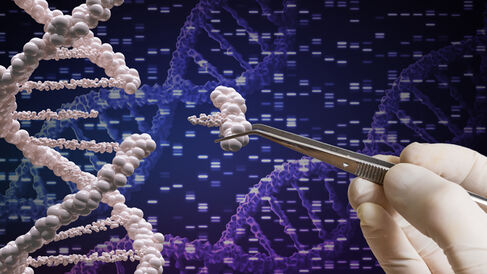
The Taipale Group, and their collaborators, have published a new paper in Nature Medicine that may improve the efficiency of CRISPR in non-tumorigenic cells.
The ability for scientists to make precise, targeted changes to the genome of living cells is essential for modern biological research. For example, RNA interference (RNAi) is currently a staple laboratory technique widely used to interrogate gene function. RNAi works through using short interfering RNAs (siRNAs) to block protein synthesis from the target gene, with the resulting absence of the target protein creating investigable cellular changes that allow the protein's normal roles to be determined. This process, however, only provides temporary inhibition of gene function, and can frequently induce unpredictable off-target effects. As such, improvement of existing methods and the discovery of new techniques for genome editing has been a long-standing goal for biomedical researchers.
In the last few years, CRISPR/Cas9 has become a highly popular genome editing tool that is now transforming the field of biology. This is due to CRISPR/Cas9 allowing scientists to edit genomes with unprecedented precision, efficiency and flexibility compared with other commonly used methods such as RNAi.
The CRISPR/Cas9 technique is based around Clustered Regularly Interspaced Short Palindromic Repeat (CRISPR) DNA sequences and the CRISPR-associated (Cas) genes that form an essential component of adaptive immunity found in some bacteria and archaea. Here, fragments of DNA from an invading virus or bacteriophage are integrated into the bacterial genome. If the bacterium then encounters the same virus again in the future, it can use these integrated fragments of viral DNA to produce small RNAs (called CRISPR RNA, crRNA) that direct the Cas9 enzyme, through sequence complementarity, to cleave the virus' foreign DNA and prevent infection.
In short, Cas9 is an enzyme that cuts DNA at the precise position indicated via the CRISPR DNA sequence. With so few components, the simplicity of this system makes it highly amenable to adapt for efficient genome editing. In the laboratory, scientists introduce both the Cas9 enzyme and guide CRISPR DNA sequences into cells to cause a DNA double-stranded break at the specified position. A repair template is also introduced into the cells, which instructs the Homology Directed Repair (HDR) pathway to repair the DNA break in the required manner (deletion of the gene, introduction of point mutations, and so on). This process is fairly efficient in some tumour cell lines.1 The genomes of normal, healthy cells have proved more difficult to edit, however, as the cells can undergo apoptosis in response to the DNA damage, or can resolve the DNA break via an alternative, error-prone mechanism (non-homologous-end-joining, NHEJ) that ignores the provided repair template.2-3 Although some recent studies have improved the efficiency of CRISPR in healthy cells,1,2,4-6 there has been no mechanistic explanation to account for its relative inefficiency in non-tumorigenic cell lines.
In their new publication, Haapaniemi et al. found that DNA double-stranded breaks created during use of CRISPR/Cas9 in the non-transformed (non-tumorigenic), but immortalised, human retinal pigment epithelium (RPE-1) cell line activate p53, causing cell growth arrest and DNA repair via the NHEJ pathway. Inhibition of p53 prevented activation of the DNA damage response during CRISPR/Cas9 treatment and promoted DNA repair via the HDR pathway using the CRISPR repair template as desired. These results suggest that CRISPR/Cas9 selects against cells with a functional p53 pathway, which can explain the higher efficiency of CRISPR/Cas9 in tumour cell lines where the p53 DNA damage response is frequently disrupted.
In the future, inhibition of p53 may improve the efficiency of genome editing in normal, healthy cells. A delicate balance is required, however, as p53 inhibition can leave cells vulnerable to tumorigenic mutations. Controlling the DNA damage response to allow efficient gene editing whilst still suppressing tumorigenesis will be important in developing the next generation of safe and efficient genome editing technologies and cell-based therapies utilising CRISPR/Cas9.
1Richardson et al., Nat. Biotechnol.34:339 (2016).
2DeWitt et al., Sci. Transl. Med.8:360ra134 (2016).
3Yin et al., Nat. Biotechnol. 32:551 (2014).
4Dever et al., Nature539:384 (2016).
5Lee et al., eLife6 (2017).
6Maruyama et al., Nat Biotechnol.33:538 (2015).
